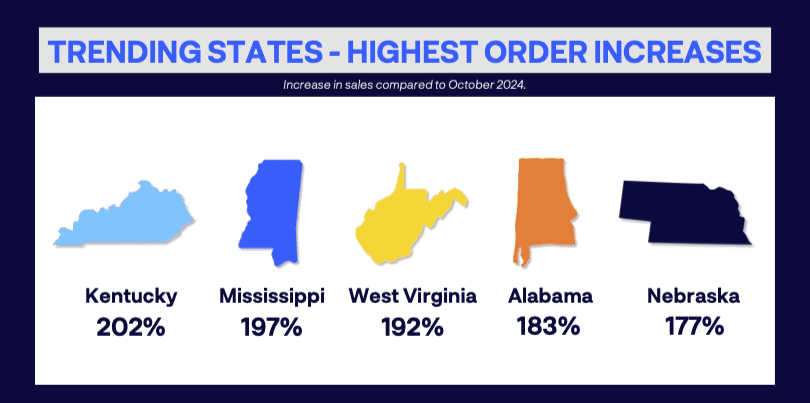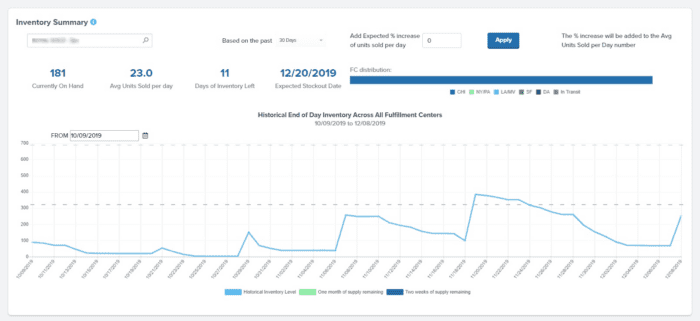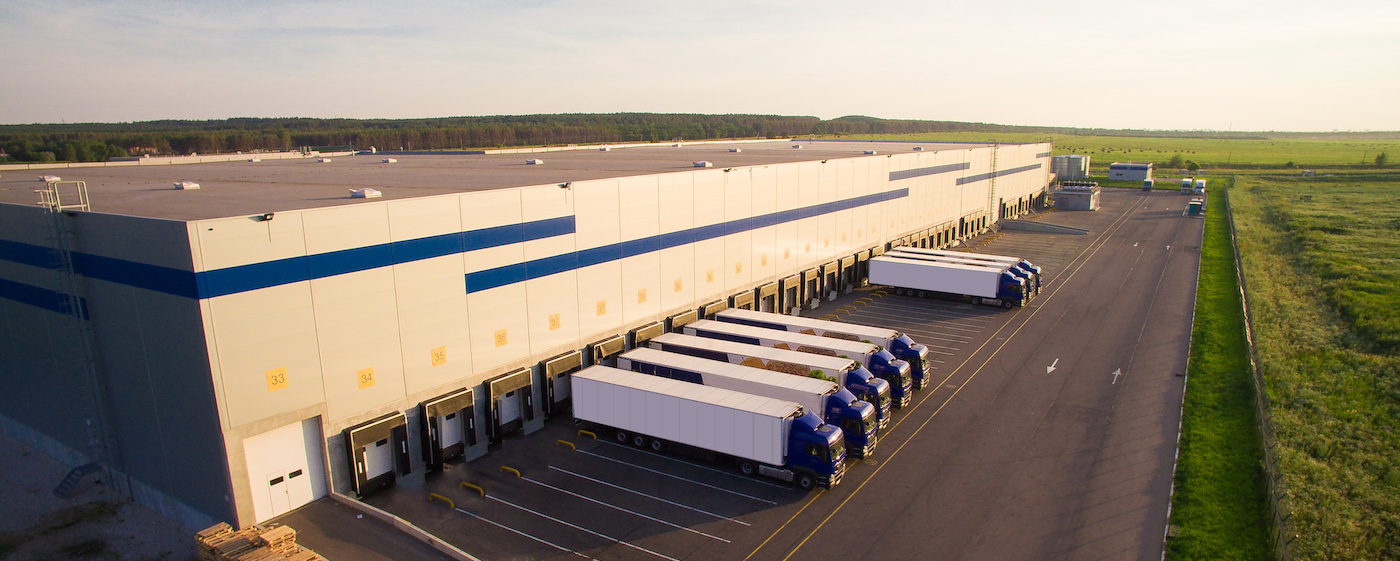Table of Contents
** Minutes
How does the devanning process work?
How an experienced 3PL like ShipBob can optimise your supply chain
In ecommerce supply chains, even the smallest tasks can have big impact.
Take the act of devanning. It may seem like a negligible aspect of the warehouse receiving and putaway process – and as a result, it often goes unappreciated and undervalued by retailers.
In reality, devanning is a complex and vital part of your warehousing operations. How a business unloads its cargo affects the speed and efficiency of other processes, and sets the stage for seamless inventory flow later on.
In this article, we’ll break down what devanning is, how it works, and best practices for leveraging this small-but-mighty task to improve your supply chain operations.
What is devanning?
Devanning is the process of unloading cargo from a sealed container and unpacking the contents.
Also known as stripping, unpacking, or unstuffing, the process involves unsealing a landed container, and taking out the contents using forklifts or other machinery.
Devanning typically takes place after drayage at the destination warehouse, where the goods can then be received and prepared for warehouse put-away.
For example, say an ecommerce business ordered 1,000 units of inventory from their supplier. The supplier sends the inventory to the business’s warehouse.
Once the container arrives at the warehouse loading dock, the business’s warehouse employees begin the deconsolidation process. Workers must place the pallets or boxes in a loading area, unwrap them, open each container, and carefully remove the inventory so that it can be stored elsewhere.
Why you shouldn’t neglect devanning in 2023
While one might assume devanning is simple, it is actually a meticulous – and consequential – process.
If devanning is sloppy, inventory may be damaged or lost in the process. This results in lost investment and revenue, and slows down the entire warehouse receiving and putaway process.
Inefficient devanning stalls every function that follows it – so for the sake of their overall supply chain efficiency, merchants should pay attention to how they devan.
Devanning requires a dedicated team of professionals that are trained in handling essential equipment and machinery such as forklifts and cranes. Workers should be experienced in the correct devanning procedures depending on the size and shape of the shipment, so they can ensure that the cargo is handed off safely and accurately.
How does the devanning process work?
The entire devanning process may take a few days, depending on the type of container and size of cargo.
The devanning crew’s experience level and the quality of equipment used also plays a role in devanning speed. In most cases, devanning a shipment can take anywhere between 1 and 3 days.
Once the cargo arrives at the destination warehouse, the containers are placed on either ground level or dock level, depending on what makes them most accessible to the devanning team. Dock-level unloading may require additional, specialized equipment.
Before unsealing the container, the devanning team should ensure that they have adequate lighting and are aware of any potential hazards, such as unsecured items or slippery floors.
After opening the container, the devanning team will use counterbalance forklifts to unload the cargo. Counterbalance forklifts have forks protruding at the front (rather than outrigging or legs or arms), and can turn on their rear wheels. This gives them the flexibility to move in and out of different spaces, and ensure greater safety and efficiency while unloading cargo.

How long it takes to unload the cargo will depend on several factors, including whether it is an FCL (full container load) or LCL (less-than-container load) shipment, and whether the container has been floor-loaded or pallet-loaded.
Once the cargo is unloaded, it is broken down by hand and palletized in a process called handballing. This allows warehousing facilities to systemically sort different cargo so that it is easier to either store the goods or transport them to a different location.
Handballing is usually time consuming. As a result, many businesses choose to outsource devanning and handballing to a logistics partner to expedite the process.
Devanning challenges
Because container devanning can be surprisingly complex, retailers may come across a number of unexpected challenges. Here are just a few common issues that arise from or affect the devanning process.
Congestion due to supply chain setbacks
Unexpected disruptions in the supply chain such as a global health crisis or transportation issues (such as the infamous Suez Canal blockage in 2021) can have a huge impact on devanning.
Often, supply chain setbacks lead to congestion, which happens when multiple containers arrive at shipping docks around the same time. This results in a traffic jam and a huge backlog of containers that need devanning. Clearing this backlog takes a lot of time, and almost always causes delays further down the supply chain.
“ShipBob was invaluable in helping us navigate the COVID supply chain crisis, especially during the 2020 holiday season.
Some fulfilment providers keep a curtain of secrecy around their operations, especially when issues arise — but not ShipBob.
Even during the worst of the pandemic, they maintained transparency and communicated with us every step of the way.”
Aaron Patterson, COO of The Adventure Challenge
Staffing shortages
Devanning requires a team of highly trained and experienced professionals. If there’s a lack of forklift operators or other workers fit to carry out the necessary tasks, the process can be seriously affected.
The pains of staffing shortages are particularly acute in the handballing process, since a business usually needs to break cargo down manually. Not having enough people to handle this will cause significant delays in the rest of your warehousing operations.
Stock identification
Depending on where inventory is coming from, there may be variations in how stock is labelled and identified.
For example, a supplier or manufacturer may not use the same labelling system or conventions that the retailer uses. This can cause confusion and mix-ups that not only waste time, but also that lead to sorting and storage errors.
Your devanning crew will need to pay close attention to how goods are labelled, so each SKU is handled and received appropriately. In some cases, you may need to relabel the goods to ensure that they can be easily identified and move seamlessly through the rest of the supply chain.
Container prioritization
When the wrong shipping container is prioritised over a container that needs to be devanned more urgently, it can cause some delays further down the line. This typically occurs due to miscommunication or lack of communication between the involved parties.
Safety risks
Since devanning often involves the use of heavy equipment and complex machinery handling huge cargo loads, there’s always a certain safety risk inherent in the unloading process.
Even a minor equipment mishandling or a small spillage on the floor could lead to expensive accidents that threaten the safety of your workers and your goods.
Devanning best practices
So what can retailers do to overcome the challenges highlighted above? Here are a few leading devanning best practices to help ensure that the process is as safe and efficient as possible.
Follow all safety protocols
In devanning, a business’s #1 priority should always be the safety of its workers. It is crucial that merchants not only have safety protocols in place, but implement them daily to minimise the risk of accidents and damaged goods.
These protocols should include:
- Positioning the container on level ground
- Arranging the container to allow for clear worker access and free movement
- Ensuring all crew members wear the required safety gear
- Checking that there is ample lighting (so workers can see what they’re doing)
- Clearing out the area before devanning
- Refusing entry into the container unless it is on an even surface
- Checking for unsecured or heavy items in the container that could fall
- Briefing and training crew members on all safety measures and proper procedures
Implement automations
The right automation tools can help address some of the common challenges retailers experience with devanning.
For instance, businesses may use devanning hands and other robotic solutions to speed up the unloading of cargo and alleviate issues related to staffing shortages and safety risks. Merchants can also use barcodes and barcode scanners to identify and sort inventory more easily, and to quickly confirm that they have received the correct items in the correct quantities.
Outsource devanning
Because devanning is a time-consuming process that requires a high level of expertise, many businesses choose to outsource it to a third-party logistics company.
That way, your brand can have an experienced team of professionals perform devanning for you, and do so correctly and safely while optimising the process for time and cost.
Ultimately, outsourcing devanning lets you leverage your 3PL partner’s industry knowledge and expertise to ensure a faster and more seamless devanning process for your brand.
Shop around for devanning services
Not all devanning services are created equal. Working with the wrong logistics partner could result in inventory issues, costly accidents, higher fees, and expensive inefficiencies – so it’s important to find the right 3PL for your business.
Use the following questions to evaluate potential logistics providers:
- Does the team have the necessary skills and expertise to handle the type of cargo you’re transporting (large vs. small shipments, fragile vs. durable, etc.)?
- Is their team experienced with equipment such as forklifts, pallets, ladders, slip sheets, ramps, conveyors, and more?
- Do they have the bandwidth to support your weekly, monthly, or and/or periodic devanning needs?
- What are their devanning and receiving SLAs?
- How do their rates compare to other 3PLs and devanning services?
- Do they provide customers with transparent pricing (no hidden fees), and offer excellent value for money?
- Can they handle other supply chain functions, including receiving, inventory storage, order processing, picking, packing, and shipping?
- How much visibility do they offer into devanning and other supply chain functions?
“ShipBob’s warehouse receiving process and documentation are really detailed. I like being able to see the SLAs so I can know when receiving will be fulfiled.
ShipBob’s analytics dashboard is quite helpful and straightforward. It’s really helpful to have that level of visibility so we don’t have to constantly email back and forth, asking when things will be completed. It saves a lot of time and helps set expectations appropriately.”
Peter Liu, Co-Founder of RIFRUF
How an experienced 3PL like ShipBob can optimise your supply chain
As a global fulfilment and logistics management solution, ShipBob can not only handle devanning for your ecommerce brand, but also streamline logistics across your entire supply chain.
ShipBob customers can store their inventory in any of our 40+ fulfilment centres worldwide. ShipBob’s warehouse receiving teams will take care of devanning it at a dock location, inspecting and counting units, and storing inventory on a pallet, shelf, or bin.
“Getting stock to the Manchester fulfilment centre has been smooth as well, thanks to ShipBob’s flexible receiving process and warehouse receiving orders, or WROs.
We don’t always know exactly when our inventory shipments will arrive from our suppliers, and other 3PLs told us they would reject our shipments if they didn’t arrive on a certain time and date.
ShipBob is a lot more flexible because of their technology, and our representative helped explain how receiving works, which was a big plus.”
Adelina Zotta & Connor Westby, Co-Founders of NutriPaw
Certain regions in the US can even enjoy a faster inbound process by sending their inventory to designated hub locations instead of regional fulfilment centres.
Once your inventory reaches these hub locations, ShipBob will take care of transferring it to the final regional fulfilment centre. This is where the goods will be stored until they’re ready to be shipped out to the customers.
ShipBob’s warehousing experts will ensure that your inventory is safely handled to minimise the risk of damage while ensuring optimal speed and efficiency. Through ShipBob’s dashboard, merchants can monitor inventory movement as ShipBob receives and stores it, and check inventory levels, SKU performance, and other KPIs in real-time.

Looking for faster freight shipping?
With our FreightBob solution powered by Flexport’s Flow Direct, we have helped over 100 ShipBob merchants get their products from China into ShipBob’s US fulfilment centres with speed, transparency, and competitive pricing.
Using FreightBob, merchants can arrange both less-than-container load (LCL) and now full-container load (FCL) freight shipments to achieve:
- Faster transit by up to 50%
- Simple, affordable rates
- Guaranteed container space
- Predetermined sailing schedules
- Distribution across the ShipBob US network
With ShipBob as your logistics partner, your brand can optimise every function in your supply chain – no matter how insignificant it may seem. By streamlining both the larger and more niche components of your order, fulfilment, and inventory management, ShipBob empowers ecommerce brands like yours to grow with ease.
Devanning FAQs
Below are the most common questions people have about devanning.
How long does devanning take?
Devanning typically takes 1-3 days, depending on the size and type of cargo as well as the skills of the devanning crew.
How does devanning fit into the larger supply chain process?
The speed and efficiency of your devanning process impacts how quickly and seamlessly a warehousing team can perform other functions further down in the supply chain. It also plays a role in your overall inventory flow, as any delay or disruption could affect other activities in your supply chain.
How much does it cost to hire a devanning service?
The cost of devanning usually starts from $175 for a basic 20ft shipment. However, the actual costs will vary depending on the size and type of cargo, and whether you select a devanning service or partner with a 3PL that includes devanning services as part of an overall package.
What equipment is needed for devanning?
Forklifts, pallets, conveyors, straps, ramps, life gates, ladders, and slip sheets are typically needed for devanning.
Is devanning applicable for Amazon FBA shipments?
Yes, Amazon FBA merchants can use a devanning service for their shipments.
How can ShipBob help with devanning?
When you partner with ShipBob, we can receive your brand’s inventory in one (or multiple) of our 40+ global fulfilment centres, or at specialized receiving hubs throughout the US.
After inspecting each shipment for damage and counting each unit, we store your inventory in our fulfilment centres before picking, packing, and shipping units in orders.



